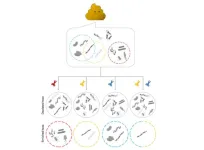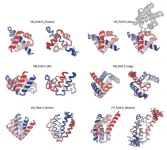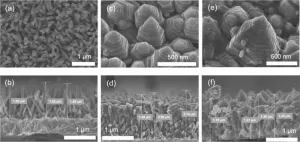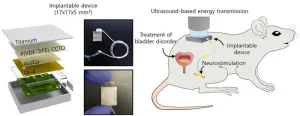(Press-News.org) In a landmark study recently published in the journal Nature Methods, researchers at the Icahn School of Medicine at Mount Sinai have unveiled mEnrich-seq—an innovative method designed to substantially enhance the specificity and efficiency of research into microbiomes, the complex communities of microorganisms that inhabit the human body.
Unlocking the Microbial World with mEnrich-seq
Microbiomes play a crucial role in human health. An imbalance or a decrease in the variety of microbes in our bodies can lead to an increased risk of several diseases. However, in many microbiome applications, the focus is on studying specific types of bacteria in a sample, rather than looking at each type present. For example, when studying infectious diseases, researchers might only be interested in a few harmful gut bacteria, but they are mixed in with many other bacteria.
"Imagine you're a scientist who needs to study one particular type of bacteria in a complex environment. It's like trying to find a needle in a large haystack," said Gang Fang, PhD, Professor of Genetics and Genomic Sciences and the study's senior author. "mEnrich-seq essentially gives researchers a 'smart tweezer’ to pick up the needle they're interested in."
Once pulled out by the “smart tweezer,” researchers can assemble the genome(s) of the targeted bacteria, facilitating the study of diverse biomedical questions about them. This new strategy addresses a critical technology gap, as previously researchers would need to isolate specific bacterial strains from a given sample using culture media that selectively grow the specific bacterium—a time-consuming process that works for some bacteria, but not others. mEnrich-seq, in contrast, can directly recover the genome(s) of bacteria of interest from the microbiome sample without culturing.
mEnrich-seq effectively distinguishes bacteria of interest from the vast background by exploiting the “secret codes” written on bacterial DNA that bacteria use naturally to differentiate among each other as part of their native immune systems.
Transforming Research and Health Care
The advent of mEnrich-seq opens new horizons in various fields:
Cost-Effectiveness: It offers a more economical approach to microbiome research, particularly beneficial in large-scale studies where resources may be limited.
Broad Applicability: The method can focus on a wide range of bacteria, making it a versatile tool for both research and clinical applications.
Medical Breakthroughs: By enabling more targeted research, mEnrich-seq could accelerate the development of new diagnostic tools and treatments.
"One of the most exciting aspects of mEnrich-seq is its potential to uncover previously missed details, like antibiotic resistance genes that traditional sequencing methods couldn't detect due to a lack of sensitivity," Dr. Fang added. "This could be a significant step forward in combating the global issue of antibiotic resistance."
Indeed, as demonstrated as one of three applications in this study, the authors used mEnrich-seq to directly reconstruct pathogenic E. coli genomes from urine samples from patients with urinary tract infections, which allowed the comprehensive analysis of the antibiotic resistance genes in each genome.
In another application, the authors used mEnrich-seq to selectively construct the genomes of Akkermansia muciniphila, a bacterium that has been shown to have benefits in obesity and diabetes, among several other diseases, as well as a response to cancer immunotherapy. This bacterium is hard to culture, so mEnrich-seq can be a useful tool to reconstruct its genome in a culture-independent, sensitive, and cost-effective way, which may facilitate larger-scale association studies with different human diseases.
The Future of mEnrich-seq
Looking ahead, the team has ambitious plans for mEnrich-seq. They aim to refine the method to improve its efficiency further and to expand its range of applications. Collaborations with clinicians and health care professionals are also in the pipeline to validate the method's utility in real-world settings.
"We envision mEnrich-seq as a sensitive and versatile tool in the future of microbiome studies and clinical applications," said Dr. Fang.
The paper is titled “mEnrich-seq: methylation-guided enrichment sequencing of bacterial taxa of interest from microbiome.”
This work was supported by a grant number R35 GM139655 from the National Institutes of Health.
Competing interests
Lei Cao and Dr. Fang are the co-inventors of a pending patent application based on the method described in this work.
-####-
About the Icahn School of Medicine at Mount Sinai
The Icahn School of Medicine at Mount Sinai is internationally renowned for its outstanding research, educational, and clinical care programs. It is the sole academic partner for the eight- member hospitals* of the Mount Sinai Health System, one of the largest academic health systems in the United States, providing care to a large and diverse patient population.
Ranked 14th nationwide in National Institutes of Health (NIH) funding and among the 99th percentile in research dollars per investigator according to the Association of American Medical Colleges, Icahn Mount Sinai has a talented, productive, and successful faculty. More than 3,000 full-time scientists, educators, and clinicians work within and across 44 academic departments and 36 multidisciplinary institutes, a structure that facilitates tremendous collaboration and synergy. Our emphasis on translational research and therapeutics is evident in such diverse areas as genomics/big data, virology, neuroscience, cardiology, geriatrics, as well as gastrointestinal and liver diseases.
Icahn Mount Sinai offers highly competitive MD, PhD, and Master’s degree programs, with current enrollment of approximately 1,300 students. It has the largest graduate medical education program in the country, with more than 2,000 clinical residents and fellows training throughout the Health System. In addition, more than 550 postdoctoral research fellows are in training within the Health System.
A culture of innovation and discovery permeates every Icahn Mount Sinai program. Mount Sinai’s technology transfer office, one of the largest in the country, partners with faculty and trainees to pursue optimal commercialization of intellectual property to ensure that Mount Sinai discoveries and innovations translate into healthcare products and services that benefit the public.
Icahn Mount Sinai’s commitment to breakthrough science and clinical care is enhanced by academic affiliations that supplement and complement the School’s programs.
Through the Mount Sinai Innovation Partners (MSIP), the Health System facilitates the real-world application and commercialization of medical breakthroughs made at Mount Sinai. Additionally, MSIP develops research partnerships with industry leaders such as Merck & Co., AstraZeneca, Novo Nordisk, and others.
The Icahn School of Medicine at Mount Sinai is located in New York City on the border between the Upper East Side and East Harlem, and classroom teaching takes place on a campus facing Central Park. Icahn Mount Sinai’s location offers many opportunities to interact with and care for diverse communities. Learning extends well beyond the borders of our physical campus, to the eight hospitals of the Mount Sinai Health System, our academic affiliates, and globally.
-------------------------------------------------------
* Mount Sinai Health System member hospitals: The Mount Sinai Hospital; Mount Sinai Beth Israel; Mount Sinai Brooklyn; Mount Sinai Morningside; Mount Sinai Queens; Mount Sinai South Nassau; Mount Sinai West; and New York Eye and Ear Infirmary of Mount Sinai.
END
Genomic ‘tweezer’ ushers in a new era of precision in microbiome research
Innovative method holds potential to reshape our understanding of bacteria's role in health and disease
2024-01-04
ELSE PRESS RELEASES FROM THIS DATE:
Scientists tame chaotic protein fueling 75% of cancers
2024-01-04
Meet MYC, the shapeless protein responsible for making the majority of human cancer cases worse. UC Riverside researchers have found a way to rein it in, offering hope for a new era of treatments.
In healthy cells, MYC helps guide the process of transcription, in which genetic information is converted from DNA into RNA and, eventually, into proteins. “Normally, MYC’s activity is strictly controlled. In cancer cells, it becomes hyper active, and is not regulated properly,” said UCR associate professor of chemistry Min Xue.
“MYC is less like food for cancer cells and more like a steroid ...
Breakthrough in designing complicated all-α protein structures
2024-01-04
A team of researchers has developed an innovative method to design complicated all-α proteins, characterized by their non-uniformly arranged α-helices as seen in hemoglobin. Employing their novel approach, the team successfully created five unique all-α protein structures, each distinguished by their complicated arrangements of α-helices. This capability holds immense potential in designing functional proteins.
This research has been published in the journal Nature Structural and Molecular Biology on January 4, 2024.
Proteins fold into unique three-dimensional structures based on their amino acid sequences, which then dictate their ...
Scientists solve mystery of how predatory bacteria recognizes prey
2024-01-04
A decades-old mystery of how natural antimicrobial predatory bacteria are able to recognize and kill other bacteria may have been solved, according to new research.
In a study published today (4th January) in Nature Microbiology, researchers from the University of Birmingham and the University of Nottingham have discovered how natural antimicrobial predatory bacteria, called Bdellovibrio bacterivorous, produce fibre-like proteins on their surface to ensnare prey.
This discovery may enable scientists to use these predators to target and kill ...
Scientists engineer plant microbiome for the first time to protect crops against disease
2024-01-04
Breakthrough could dramatically cut the use of pesticides and unlock other opportunities to bolster plant health
Scientists have engineered the microbiome of plants for the first time, boosting the prevalence of ‘good’ bacteria that protect the plant from disease.
The findings published in Nature Communications by researchers from the University of Southampton, China and Austria, could substantially reduce the need for environmentally destructive pesticides.
There is growing public awareness about the significance of our microbiome – the myriad of microorganisms that live in and around our bodies, most notably in our guts. Our gut ...
Chiba University is pleased to announce the International Conference: “Humanities In The Age Of Space Exploration”
2024-01-04
Introduction to the Event: As the world witnesses rapid technological advancements and the increasing reality of space travel and habitation, Chiba University is taking the lead in shaping the dialogue on the future of space development and humanity. The upcoming conference will feature distinguished speakers from Chiba University and international institutions, converging to facilitate interdisciplinary discussions. Through diverse lenses encompassing philosophy, ethics, law, political science, and horticulture, the conference aims to gain profound insights, welcoming active ...
US study offers a different explanation why only 36% of psychology studies replicate
2024-01-04
In light of an estimated replication rate of only 36% out of 100 replication attempts conducted by the Open Science Collaboration in 2015 (OSC2015), many believe that experimental psychology suffers from a severe replicability problem.
In their own study, recently published in the open-access peer-reviewed scientific journal Social Psychological Bulletin, Drs Brent M. Wilson and John T. Wixted at the University of California San Diego (USA) suggest that what has since been referred to as a “replication crisis” might not be as bad as it seems.
“No one asks a critical question,” the scientists argue, “if ...
Development of zinc oxide nanopagoda array photoelectrode
2024-01-04
Overview
A research team consisting of members of the Egyptian Petroleum Research Institute and the Functional Materials Engineering Laboratory at the Toyohashi University of Technology, has developed a novel high-performance photoelectrode by constructing a zinc oxide nanopagoda array with a unique shape on a transparent electrode and applying silver nanoparticles to its surface. The zinc oxide nanopagoda is characterized by having many step structures, as it comprises stacks of differently sized hexagonal prisms. In addition, it exhibits very few crystal defects and excellent electron conductivity. By decorating its surface with silver nanoparticles, the zinc oxide nanopagoda ...
Vitamin discovered in rivers may offer hope for salmon suffering from thiamine deficiency disease
2024-01-04
CORVALLIS, Ore. – Oregon State University researchers have discovered vitamin B1 produced by microbes in rivers, findings that may offer hope for vitamin-deficient salmon populations.
Findings were published in Applied and Environmental Microbiology.
The authors say the study in California’s Central Valley represents a novel piece of an important physiological puzzle involving Chinook salmon, a keystone species that holds significant cultural, ecological and economic importance in the Pacific Northwest and Alaska.
Christopher ...
An electrophysiological breakthrough for diabetic brain studies
2024-01-04
Overview
A research team from the Institute for Research on Next-generation Semiconductor and Sensing Science (IRES²) at the Toyohashi University of Technology, National Institute of Technology, Ibaraki College, and TechnoPro R&D Company has successfully demonstrated low-invasive neural recording technology for the brain tissue of diabetic mice. This was achieved using a small needle-electrode with a diameter of 4 µm. Recording neuronal activity within the diabetic brain tissue is particularly challenging due to various complications, including the development of cerebrovascular disease. Because of the significant advantage of the miniaturized needle-electrode compared to conventional ...
Using static electricity to enhance biomedical implant durability
2024-01-04
Medical technology innovations achieved by integrating science and medicine have improved the quality of life for patients. Especially noteworthy is the emergence of electronic devices implanted in the body, such as in the heart or brain, which enable real-time measurement and regulation of physiological signals, presenting new solutions for challenging conditions like Parkinson's disease. However, technical constraints have hindered the semi-permanent use of electronic devices after their implantation.
A collaborative research team led by Professor Sung-Min Park from the Departments of Convergence IT Engineering, Mechanical Engineering, and ...
LAST 30 PRESS RELEASES:
University of Oklahoma researcher awarded funding to pursue AI-powered material design
Exploring how the visual system recovers following injury
Support for parents with infants at pediatric check-ups leads to better reading and math skills in elementary school
Kids’ behavioral health is a growing share of family health costs
Day & night: Cancer disrupts the brain’s natural rhythm
COVID-19 vaccination significantly reduces risk to pregnant women and baby
The role of vaccination in maternal and perinatal outcomes associated with COVID-19 in pregnancy
Mayo Clinic smartwatch system helps parents shorten and defuse children's severe tantrums early
Behavioral health spending spikes to 40% of all children’s health expenditures, nearly doubling in a decade
Digital cognitive behavioral treatment for generalized anxiety disorder
Expenditures for pediatric behavioral health care over time and estimated family financial burden
Air conditioning in nursing homes and mortality during extreme heat
The Alps to lose a record number of glaciers in the next decade
What makes a good proton conductor?
New science reporting guide published for journalists in Bulgaria
New international study reveals major survival gaps among children with cancer
New science reporting guide published for journalists in Turkey
Scientists develop a smarter mRNA therapy that knows which cells to target
Neuroanatomy-informed brain–machine hybrid intelligence for robust acoustic target detection
Eight SwRI hydrogen projects funded by ENERGYWERX
The Lundquist Institute and its start-up company Vitalex Biosciences Announces Strategic Advancement of Second-Generation fungal Vaccine VXV-01 through Phase 1 Trials under $40 Million Competitive Con
Fine particles in pollution are associated with early signs of autoimmune disease
Review article | Towards a Global Ground-Based Earth Observatory (GGBEO): Leveraging existing systems and networks
Penn and UMich create world’s smallest programmable, autonomous robots
Cleveland researchers launch first major study to address ‘hidden performance killer’ in athletes
To connect across politics, try saying what you oppose
Modulating key interaction prevents virus from entering cells
Project explores barriers to NHS career progression facing international medical graduates
Jeonbuk National University researchers explore the impact of different seasonings on the flavor perception of Doenjang soup
Two Keck Medicine of USC Hospitals named Leapfrog Top Teaching Hospitals
[Press-News.org] Genomic ‘tweezer’ ushers in a new era of precision in microbiome researchInnovative method holds potential to reshape our understanding of bacteria's role in health and disease







